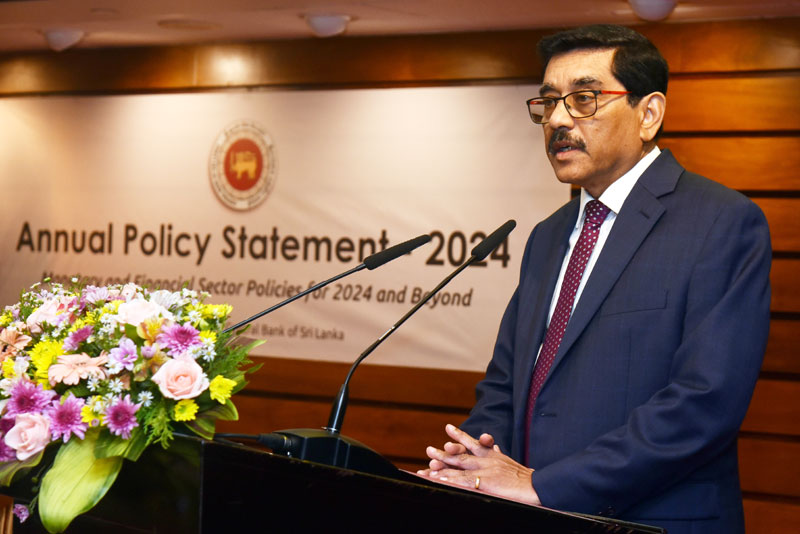Friday Dec 05, 2025
Friday Dec 05, 2025
Thursday, 11 January 2024 02:05 - - {{hitsCtrl.values.hits}}

Central Bank Governor Dr. Nandalal Weerasinghe – Pic by Ruwan Walpola
By Charumini de Silva
The Central Bank announced yesterday that it plans to consider adopting a single policy rate mechanism in 2024 while maintaining a low interest rate and pushing forward with the International Monetary Fund (IMF) program, external debt restructuring and reform agenda. Unveiling the ‘Annual Policy Statement 2024’ the Central Bank Governor Dr. Nandalal Weerasinghe detailed a raft of bold, progressive ongoing and planned measures to ensure a sustained recovery of the economy.
“The Central Bank would consider moving towards a single policy interest rate mechanism, instead of the existing dual policy interest rates to improve the monetary policy transmission and signalling effect of the policy stance,” he said.
At present, the Central Bank employed two interest rates—the Standing Deposit Facility Rate (SDFR) and the Standing Lending Facility Rate (SLFR).
Noting that the introduction of a single policy rate is not novel, Dr. Weerasinghe highlighted that further information on the implementation would be announced soon.
The Governor emphasised the commitment to maintaining CCPI-based headline inflation at 5%, as agreed with the Government under the Monetary Policy Framework Agreement.
However, he acknowledged that recent inflation upticks due to administrative measures might not necessitate an immediate shift in monetary policy.
“Although the underlying demand pressures remain subdued at present, the Central Bank will remain vigilant of any developments that could challenge the inflation outlook. Thereby, it is possible to implement proactive monetary policy measures to ensure domestic price stability,” he explained.
He also announced that the Central Bank will introduce an Open Market Operations (OMO) auction schedule this year.
“To enhance the effectiveness of monetary policy implementation as well as catering the current and future developments, a user-friendly system for OMO would be introduced, with a smooth transition to the new auction system by 2025,” he added.
The OMO auction schedule is an indicative calendar published in advance to the Participating Institutions (PIs) to guide on the dates on which OMO auctions are to be conducted, typically to manage money market liquidity by the Central Bank.
Additionally, the Central Bank plans to review the Statutory Reserve Requirement (SRR) framework, aligning it with international best practices. This aims to enhance flexibility for Licensed Commercial Banks (LCBs) in managing reserves and supporting the payment system while optimising SRR as a monetary policy instrument.
“The proposed policies would involve stakeholder consultation before implementation, with the overarching goal of optimising the SRR framework for the benefit of the broader economy and the financial system,” Dr. Weerasinghe assured.
To prevent an overreliance on liquidity facilities, the Central Bank has placed restrictions on access to standing facilities. Dr. Weerasinghe stated that if market activity improves, these can be revisited in future.
The Governor highlighted the importance of completing the IMF bailout program and progressing with external debt restructuring as top priorities whilst identifying upcoming elections and interest rates as short-term risks, underlining the need for preparedness.
“The completion of external debt restructuring and the successful continuation of the IMF program would be instrumental in eliminating the prevailing market uncertainties and improving investor confidence on a sustainable basis,” he added.
He cautioned against derailing the program, citing potential credibility loss with creditors and the return to a more challenging economic scenario.
The Governor also pointed out that sustaining the momentum in workers’ remittances and attracting non-debt obligatory foreign financial inflows would be instrumental in ensuring lasting stability in the external sector.
Dr. Weerasinghe expressed confidence in the autonomy of the Central Bank to formulate effective policies.
He said the Central Bank remains committed to maintaining a market-determined and flexible exchange rate to serve as a buffer against external shocks. “The Central Bank’s intervention in the market would be limited only for reserve build-up and to curtail any excessive volatility in the exchange rate,” he added.
The Central Bank also plans to report monthly data on the external current account, particularly on trade in services, based on International Transactions Reporting System (ITRS) data from 2024 onwards.
“All banks are urged to continue to support the development of the ITRS system and to ensure the coverage, accuracy and timeliness of data,” he said.
The Governor reflects the commitment of the Central Bank to foster a stable and prosperous economy for all Sri Lankans. He urged collective efforts and collaboration with stakeholders to ensure the effective implementation of the outlined policies, acknowledging the significant challenges faced by the country.
«By working collectively we can achieve a brighter future with policy adjustments that may require based on evolving internal and external economic conditions,» Dr. Weerasinghe expressed optimism.
